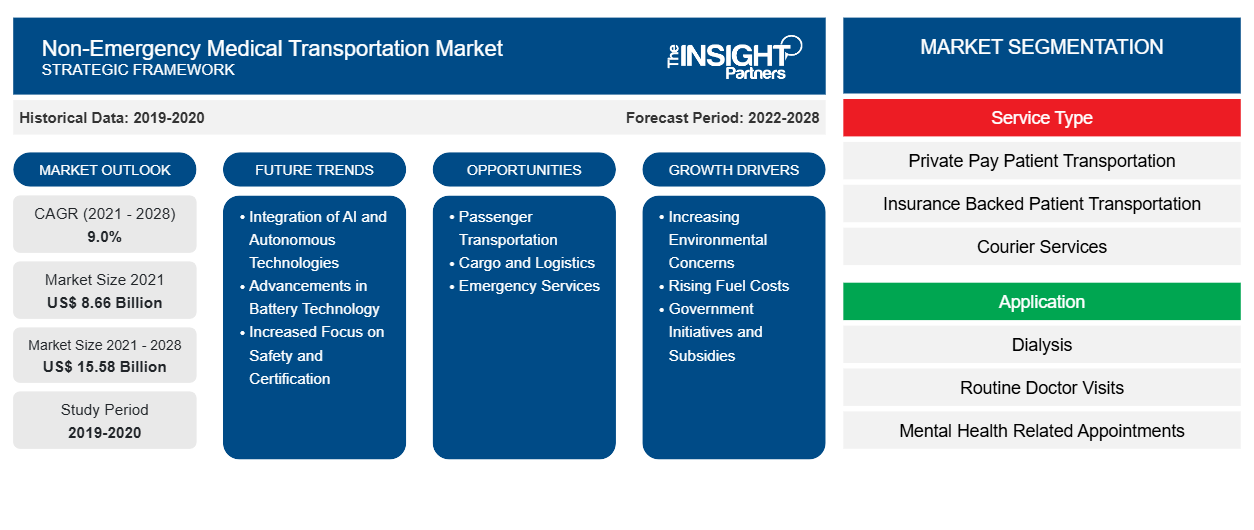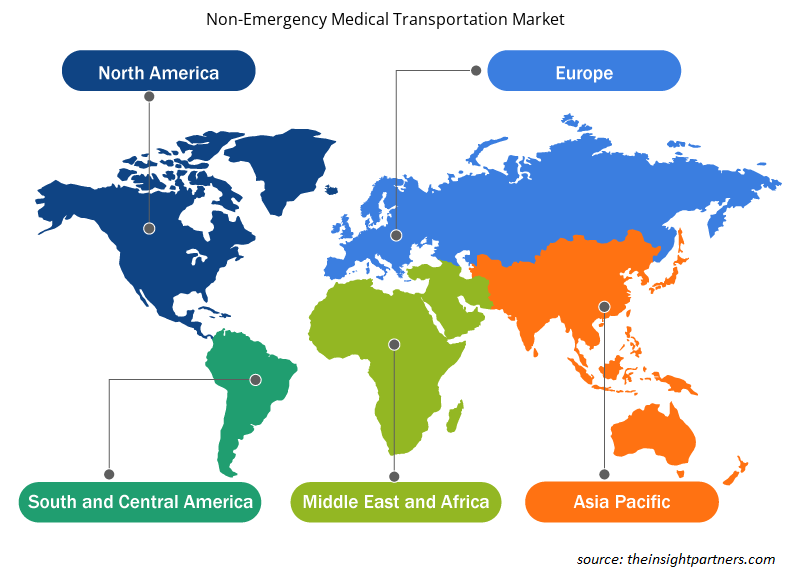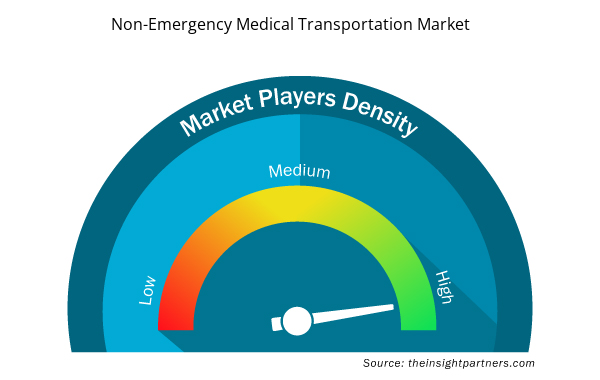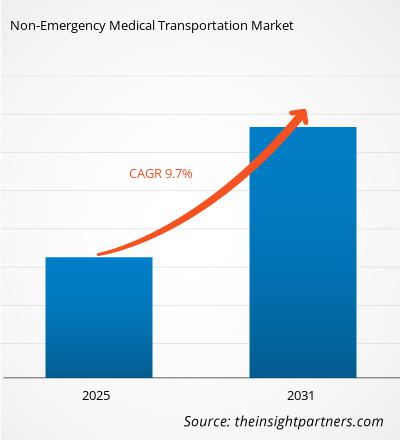The non-emergency medical transportation market size is projected to reach US$ 31,872.49 million by 2031 from US$ 16,714.80 million in 2024. The market is expected to register a CAGR of 9.7% during 2025–2031. Technology advancements in non-emergency medical transportation are likely to bring new trends in the market in the coming years.
Non-Emergency Medical Transportation Market Analysis
The factors driving the non-emergency medical transportation market include the increasing need for non-emergency medical transportation and the surging incidence of chronic conditions in aging populations. Additionally, technological developments in the field of non-emergency medical transportation are expected to contribute to the market growth. Strategic initiatives by market players are expected to create ample opportunities in the coming years.
Non-Emergency Medical Transportation Market Overview
North America is expected to dominate the non-emergency medical transportation market, and Asia Pacific is expected to register a significant growth rate owing to the increasing prevalence of chronic diseases among geriatric people and the growing demand for improved healthcare solutions. The increasing healthcare expenditure and the development of healthcare infrastructure, along with surging medical tourism, have also increased the demand for non-emergency medical transportation in the regions. In APAC, China accounts for the major market share, and India registers a significant growth rate in the region. China plans to invest US$ 1.5 trillion over the next few years to further advance its healthcare technology innovation. In addition to the Healthy China 2030 plan, this expenditure is intended to ensure health equity within China through technological advancements and improvements to the healthcare system. According to a report from the Ministry of Civil Affairs and the China National Committee on Ageing, China has one of the largest aging populations in the world. In 2023, there were more than 297 million people aged 60 and older, i.e., 21.1% of the total population. China's geriatric population faces an increasing burden from chronic diseases, with advancing age being the primary risk factor contributing to disease occurrence. According to the study "Unmet Needs for Chronic Diseases in China," published in the BMJ Journal in 2024, noncommunicable diseases (NCDs) represent the most significant health threat in the country, accounting for 91% of all deaths. The primary NCDs in China include cardiovascular diseases (43%), cancers (23%), and diabetes mellitus (2%).
Customize This Report To Suit Your Requirement
You will get customization on any report - free of charge - including parts of this report, or country-level analysis, Excel Data pack, as well as avail great offers and discounts for start-ups & universities
Non-Emergency Medical Transportation Market: Strategic Insights

- Get Top Key Market Trends of this report.This FREE sample will include data analysis, ranging from market trends to estimates and forecasts.
Customize This Report To Suit Your Requirement
You will get customization on any report - free of charge - including parts of this report, or country-level analysis, Excel Data pack, as well as avail great offers and discounts for start-ups & universities
Non-Emergency Medical Transportation Market: Strategic Insights

- Get Top Key Market Trends of this report.This FREE sample will include data analysis, ranging from market trends to estimates and forecasts.
Non-Emergency Medical Transportation Market Drivers and Opportunities
Increasing Demand for Non-Emergency Medical Transportation
According to the American Hospital Association, each year, ~3.6 million individuals in the US do not obtain necessary medical attention due to transportation issues (lack of vehicle access, long distances to healthcare facilities, inadequate public transportation infrastructure, and the cost of transportation). A study by UC Davis Health revealed that ~5.8 million Americans experience missed or delayed medical care each year due to transportation barriers. Transportation is a significant factor contributing to missed medical appointments. A 2019 survey by Kaiser Permanente found that one-third of Americans frequently or occasionally undergo stress due to transportation.
Since 1965, Medicaid has had a non-emergency medical transportation (NEMT) benefit, and people covered by Medicaid are provided with transportation services as an essential benefit. As per Medicaid Enrollment and Unwinding Tracker, ~94 million individuals in total were enrolled in Medicaid till April 2023. The KFF Medicaid Budget Survey anticipated an 8.2% increase in healthcare membership in 2021 in the US, primarily driven by the COVID-19 crisis and elevated unemployment rate. As more people gain access to Medicaid, there is a direct increase in the demand for NEMT services.
Most of the states in the US have transitioned to deliver NEMT through NEMT brokers or managed care organizations (MCOs). In many states, the brokers or MCOs receive a per capita payment to oversee the NEMT services, while other states, including Nevada, Arizona, and Vermont, deliver NEMT on a fee-for-service basis through local service providers. The Children's Health Insurance Program (CHIP) offers health coverage to eligible children via Medicaid and separate CHIP programs. CHIP is administered by states in accordance with federal requirements and jointly funded by state and federal governments. Therefore, with an increase in such initiatives by governments, the demand for NEMT is increasing, thereby driving market growth.
Strategic Initiatives by NEMT and Transportation Network Companies Create Ample Opportunities for Market Growth
NEMT companies and transportation network companies (TNCs) are eager to undertake strategic actions to improve access to care. TNCs, such as Uber or Lyft, are known for their on-demand ride-hailing capabilities and user-friendly mobile apps. These features can effectively address the availability and scheduling issues related to NEMT services. Various TNCs are currently developing new platforms or are engaged in collaborations with NEMT and individual healthcare service providers across the globe. Several state agencies are allowing the use of TNCs to provide NEMT services. A few examples are given below.
- In June 2024, Uber officially introduced Uber Health, a platform aimed at helping patients reach their medical appointments, which could reduce no-shows and enhance punctuality. This initiative is HIPAA-compliant and offers a cost-effective alternative to traditional taxi services, particularly benefiting smaller healthcare organizations lacking dedicated transportation resources. With coverage in over 250 US cities, Uber's healthcare-focused platform significantly broadens access to NEMT.
- In January 2024, MediDrive, a CTG partner company, formally entered the NEMT market. The company is dedicated to addressing the complexities of transporting patients to and from their healthcare appointments and procedures.
- In June 2022, MTM launched the Elevate program to provide proactive trip management. MTM takes a proactive approach to managing trips for members in its Elevate Program, providing concierge-level service for complex journeys and addressing the unique transportation needs of its members.
- In February 2022, Modivcare Inc. launched Modivcare Academy. This innovative initiative aims to assist transportation providers in NEMT by delivering educational resources, networking opportunities, and training. The program uniquely equips transportation providers with essential business tools, best practices, and training to effectively support the care of the nation's most vulnerable populations.
Such strategic initiatives focus on enhancing service efficiency, increasing patient accessibility, reducing operational costs, and ensuring better integration with healthcare services. As the NEMT sector continues to grow, these initiatives will be crucial in expanding services and improving the quality of patient care across the globe.
Non-Emergency Medical Transportation Market Report Segmentation Analysis
Key segments that contributed to the derivation of the non-emergency medical transportation market analysis are service type, facility, application, and end user.
- Based on service type, the non-emergency medical transportation market is segmented into private pay patient transportation, insurance backed patient transportation, courier services, and others. The private pay patient transportation segment held the largest share of the market in 2024 and is expected to register the highest CAGR in the market during 2024–2031.
- By facility, the non-emergency medical transportation market is bifurcated into intra-facility and inter-facility. The inter-facility segment held a larger share of the market in 2024 and is expected to register a higher CAGR in the market during 2024–2031.
- By application, the non-emergency medical transportation market is segmented into dialysis, routine doctor visits, mental health-related appointments, rehabilitation, and others. The mental health-related appointments segment held the largest share of the market in 2024; the rehabilitation segment is expected to register the highest CAGR in the market during 2024–2031.
- In terms of end user, the non-emergency medical transportation market is segmented into hospitals & clinics, nursing homes, homecare settings, MCO & state agencies, healthcare payers, and others. The hospitals and clinics segment dominated the market in 2024, and the nursing home segment is anticipated to register the highest CAGR during 2024–2031.
Non-Emergency Medical Transportation Market Share Analysis by Geography
The geographical scope of the non-emergency medical transportation market report is mainly divided into five regions: North America, Asia Pacific, Europe, Middle East & Africa, and South & Central America.
North America held a significant share of the market in 2023. The growth of the non-emergency medical transportation market is attributed to the increasing prevalence of various diseases, expanding insurance coverage for non-emergency medical transportation (NEMT), and a high state-wise rate of reimbursement for these services as administrative or medical expenses. In addition, a shift toward patient-centered care, heightened awareness of NEMT, and technological advancements are among the other factors supporting the growth of the market. Chronic illnesses, old age, disabilities, injuries, and obesity are just a few of the many reasons owing to which Americans rely on non-emergency medical transportation services. The pandemic generated an enormous need for reliable car transportation to get to appointments, essential doctor visits, and daily treatments. In addition, the increase in the number of senior citizens is contributing to the growth of the non-emergency medical transportation market in the country. Additionally, companies operating in the market are adopting organic and inorganic development strategies for market expansion. Below are a few instances of the same:
- Coastal Medical Transportation Systems (CMTS), a privately owned medical transportation company based in Massachusetts, acquired Transformative Healthcare's medical transportation division in September 2022. This division included LifeLine Ambulance Service and Fallon Ambulance Service. As a result of this acquisition, CMTS became one of the largest ambulance networks in the state, both in terms of the number of patients served and the geographic area covered.
- In September 2022, Baystate Wing Hospital partnered with Quaboag Connector to provide transportation services for healthcare in Massachusetts. This curb-to-curb service offers NEMT, allowing patients to request rides to and from medical appointments at Baystate Wing Hospital facilities.
Non-Emergency Medical Transportation Market Regional Insights
The regional trends and factors influencing the Non-Emergency Medical Transportation Market throughout the forecast period have been thoroughly explained by the analysts at Insight Partners. This section also discusses Non-Emergency Medical Transportation Market segments and geography across North America, Europe, Asia Pacific, Middle East and Africa, and South and Central America.

- Get the Regional Specific Data for Non-Emergency Medical Transportation Market
Non-Emergency Medical Transportation Market Report Scope
| Report Attribute | Details |
|---|---|
| Market size in 2024 | US$ 16,714.80 Million |
| Market Size by 2031 | US$ 31,872.49 Million |
| Global CAGR (2025 - 2031) | 9.7% |
| Historical Data | 2021-2023 |
| Forecast period | 2025-2031 |
| Segments Covered |
By Service Type
|
| Regions and Countries Covered | North America
|
| Market leaders and key company profiles |
Non-Emergency Medical Transportation Market Players Density: Understanding Its Impact on Business Dynamics
The Non-Emergency Medical Transportation Market market is growing rapidly, driven by increasing end-user demand due to factors such as evolving consumer preferences, technological advancements, and greater awareness of the product's benefits. As demand rises, businesses are expanding their offerings, innovating to meet consumer needs, and capitalizing on emerging trends, which further fuels market growth.
Market players density refers to the distribution of firms or companies operating within a particular market or industry. It indicates how many competitors (market players) are present in a given market space relative to its size or total market value.
Major Companies operating in the Non-Emergency Medical Transportation Market are:
- MTM, Inc.
- AMR
- Xpress Transportation
- CJ Medical Transportation
- VERIDA
Disclaimer: The companies listed above are not ranked in any particular order.

- Get the Non-Emergency Medical Transportation Market top key players overview
Non-Emergency Medical Transportation Market News and Recent Developments
The non-emergency medical transportation market is evaluated by gathering qualitative and quantitative data post primary and secondary research, which includes important corporate publications, association data, and databases. A few of the developments in the non-emergency medical transportation market are listed below:
- Modivcare Inc. launched its Integration Hub, a groundbreaking digital platform that revolutionizes engagement and experience for Medicaid and Medicare members with NEMT benefits. Modivcare’s Integration Hub is an industry-first providing an extensible modular mobility platform that exposes open Application Programming Interfaces (API) to its commercial health plan clients, state Medicaid agencies, and facility partners. (Source: ModivCare, Company Website, May 2024)
- MTM, the nation’s largest privately held NEMT broker, signed an agreement with Global Medical Response to acquire Access2Care, LLC. This strategic acquisition significantly enhanced MTM’s market presence and increased total annual revenue, marking a milestone in the company’s growth trajectory. The acquisition of Access2Care's NEMT business comes after careful consideration and aligns with MTM's strategic expansion initiatives. (Source: MTM, Inc, Company Website, August 2024)
- Acadian Ambulance Service announced the execution of an agreement to substantially acquire all of SouthernCross Ambulance's assets, an EMS provider based in New Braunfels, Texas. This acquisition enables Acadian to operate 12 additional ambulances and 10 additional wheelchair vans and bring on new employees. SouthernCross Ambulance offers emergent and non-emergent ambulance transportation services to South-Central and South Texas areas, providing local and long-distance ambulance transportation to and from hospitals, rehabilitation centers, clinics, nursing homes, and skilled nursing centers. (Source: Acadian Ambulance Service, Company Website, January 2024)
Non-Emergency Medical Transportation Market Report Coverage and Deliverables
The “Non-Emergency Medical Transportation Market Size and Forecast (2021–2031)” report provides a detailed analysis of the market covering below areas:
- Non-emergency medical transportation market size and forecast at global, regional, and country levels for all the key market segments covered under the scope
- Non-emergency medical transportation market trends as well as market dynamics such as drivers, restraints, and key opportunities
- Detailed PEST and SWOT analysis
- Non-emergency medical transportation market analysis covering key market trends, global and regional framework, major players, regulations, and recent market developments
- Industry landscape and competition analysis covering market concentration, heat map analysis, prominent players, and recent developments for the non-emergency medical transportation market
- Detailed company profiles
- Historical Analysis (2 Years), Base Year, Forecast (7 Years) with CAGR
- PEST and SWOT Analysis
- Market Size Value / Volume - Global, Regional, Country
- Industry and Competitive Landscape
- Excel Dataset


- Pharmacovigilance and Drug Safety Software Market
- Europe Surety Market
- Photo Editing Software Market
- Data Annotation Tools Market
- Wind Turbine Composites Market
- Extracellular Matrix Market
- Railway Braking System Market
- Oxy-fuel Combustion Technology Market
- Latent TB Detection Market
- UV Curing System Market

Report Coverage
Revenue forecast, Company Analysis, Industry landscape, Growth factors, and Trends

Segment Covered
Service Type, and Application

Regional Scope
North America, Europe, Asia Pacific, Middle East & Africa, South & Central America

Country Scope
Argentina, Australia, Brazil, Canada, China, France, Germany, India, Italy, Japan, Mexico, Saudi Arabia, South Africa, South Korea, Spain, United Arab Emirates, United Kingdom, United States
Frequently Asked Questions
The global non-emergency medical transportation market is estimated to register a CAGR of 9.7% during the forecast period.
The estimated value of the non-emergency medical transportation market can reach US$ 31,872.49 million by 2031.
North America dominated the non-emergency medical transportation market in 2024.
The increasing increasing need for non-emergency medical transportation and surging incidence of chronic conditions among aging populations. arethe most influential factors responsible for the market growth.
MTM, Inc.; AMR; Xpress Transportation; CJ Medical Transportation; VERIDA; ModivCare; Crothall Healthcare; Elite Medical Transport; Acadian Ambulance Service; Transdev; Ride Health; Roundtrip; Medical Answering Services, LLC; One Call; Stellar Transport; Abba Medical Transportation, LLC; Able Medical Transportation, Inc.; Life Ride; Mobility Transportation Services, Inc.; and ABC Non-Emergency Medical Transportation, LLC are among the key players operating in the non-emergency medical transportation market.
Trends and growth analysis reports related to Life Sciences : READ MORE..
The List of Companies - Non-Emergency Medical Transportation Market
- MTM, Inc.
- AMR
- Xpress Transportation
- CJ Medical Transportation
- VERIDA
- ModivCare
- Crothall Healthcare
- Elite Medical Transport
- Acadian Ambulance Service
- Transdev
- Ride Health
- Roundtrip
- Medical Answering Services, LLC
- One Call
- Stellar Transport
- Abba Medical Transportation, LLC
- Able Medical Transportation, Inc.
- Life Ride
- Mobility Transportation Services, Inc.
- ABC Non-Emergency Medical Transportation, LLC

 Get Free Sample For
Get Free Sample For